

Acer Swift 5: A lightweight in any case
The Acer Swift 5 weighs 970 grams. How does the device perform in everyday use? I tested it for you over the course of a week.
"Is this a dummy?" my colleague David Lee asks me as he picks up the Swift. No, it's actually a fully functional notebook. To be honest, I felt exactly the same the first time I touched it.
Acer packs the following components into the 22.8 cm long, 32.9 cm wide and 1.5 cm high notebook:
- Intel Core i7-8550U with 1.8 GHz
- Intel UHD Graphics 620
- 16 GB LPDDR3 RAM
- 512 GB SSD
- 14" IPS Full HD high-gloss touchscreen
- 2-cell lithium polymer battery with 36 Wh
- Windows 10 Home

Design and connections
At first glance, the Swift 5 makes a high-quality impression. I really like the blue colour, which shines differently depending on the incidence of light. Unfortunately, the good impression fades when I pick up the device. The outer part of the casing is made of a magnesium-lithium alloy. I normally like this material, but it doesn't feel particularly valuable on the Swift 5. I have the feeling that I'm holding a plastic casing in my hands. It also magically attracts fingerprints.
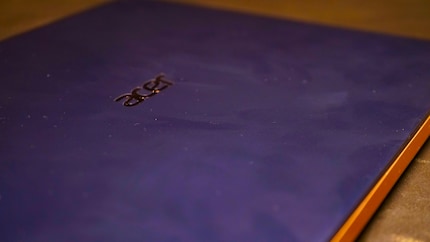
This impression is confirmed when you open it for the first time. Like so many ultrabooks, the Swift 5 cannot be opened with one hand. When I try to fold up the display, the lower part comes with it because it is so light. When I fold it up, I notice that the display bends slightly.
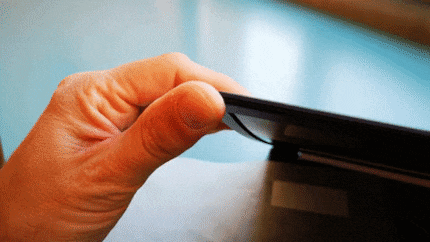
In contrast to the outer part, the inner part is made of a magnesium-aluminium alloy. The inner part has a clear structure. Everything has its place. The golden hinge, which complements the golden key imprints, is an eye-catcher. In addition to the keyboard and trackpad, there is also a fingerprint scanner on the right below the keyboard. This worked perfectly during the test phase.
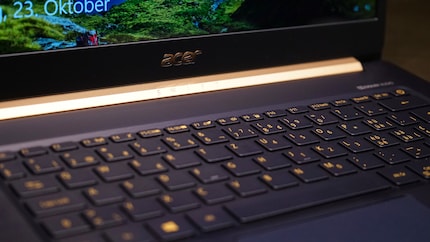
In terms of connections, Acer provides the bare essentials. In addition to the power connection, there are two USB Type-A 3.0 ports, one USB Type-C 3.0 port and an HDMI output on the right-hand side. On the left-hand side is a jack connection and the status LEDs.
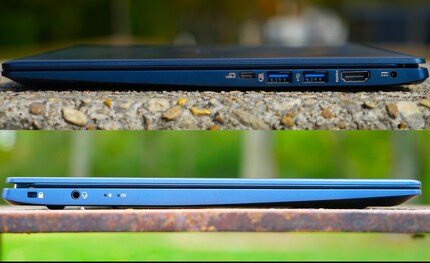
Display
The IPS display has a resolution of 1080p. In the EIZO monitor test, I could not find any negative abnormalities. The display has no pixel errors, gradients are clearly displayed, the grey tones are homogeneous and text is reproduced sharply.
The viewing angle stability, on the other hand, does not convince me. From around 135° horizontally, the display no longer shows the image clearly. Vertically, the image is no longer clear at 110°. The glossy display is also very reflective. Working in bright rooms or outdoors proves to be difficult.
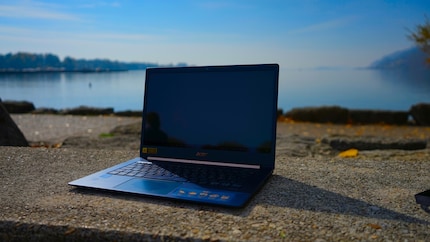
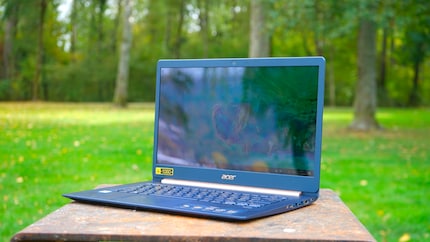
The Swift 5 has a touchscreen. If the Swift were foldable, I would see the point of the touchscreen. However, the device can neither be folded down nor used in tent mode. Fold it 180° and you're done. The touchscreen is a nice gimmick, but I personally don't use it in this case. However, I did of course test the touchscreen for the review. It works reliably.
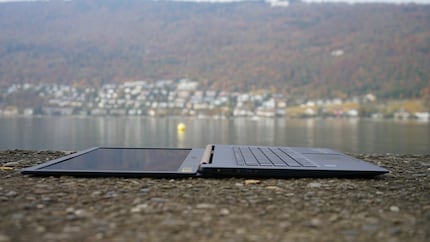
Keyboard and trackpad
The keyboard offers pleasant feedback. The key travel is slightly higher than I'm used to from other ultrabooks, which makes typing very comfortable. Unfortunately, the keys are not very grippy. With somewhat sweaty fingertips, I kept slipping.
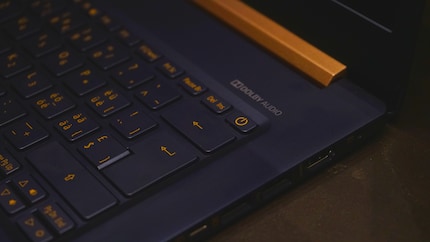
Another drawback of the keyboard is that Acer has integrated the power key into the keyboard - right above the backspace key and to the right of the delete key. I kept accidentally pressing the power key while typing. It's a mystery to me why it's placed there of all places. There would be enough space above the keyboard.
Some of the keys are overloaded with labelling. Acer probably wanted to fit everything in somehow. The space for the palm rest is okay for a 14-inch notebook.
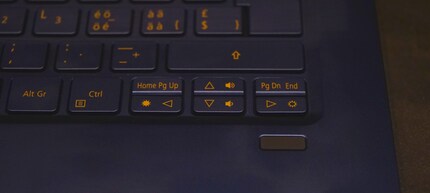
The trackpad is rather small, but offers good feedback. Unfortunately, it cracks loudly when I really press it to click.
Battery
With 36 Wh, the battery of the Swift 5 is very small. Acer has clearly sacrificed battery life for less weight. This is also evident in everyday work on the notebook. In office use with writing, browsing and occasionally watching a YouTube video, the Swift ran out of breath after around four hours.
To see how long the device can last under continuous load, I run the Heavyload stress test. This keeps the CPU, graphics card, RAM and hard drive busy. The Swift 5 lasts around 2 hours and 15 minutes with this test. With this result, the Swift 5 beats every ultrabook in our colleague Martin Jud's comparison test.
Acer does not use Quick Charge on the Swift 5. One full charge takes a good hour and a half.
At this point, I would like to say a few words about noise emissions. In office mode, the Swift 5 is not audible at all. I could hear the fan during the stress test, but it wasn't loud enough to be annoying.
Performance
The Intel Core i7-8550U is a quad-core processor with up to eight threads. It employees at a clock speed of 1.8 GHz and has a TDP of 15 W. An Intel UHD Graphics 620 is installed on the chip. The Swift 5 is absolutely not a powerhouse. It is not suitable for gaming. However, for everyday tasks such as streaming, office and browsing, it is more than sufficient and the applications are launched quickly. The performance is even sufficient for editing photos and videos up to Full HD. However, larger rendering tasks take a lot of time.
Cinebench R15 [[image:17393814]]
The Cinebench R15 results reflect the Swift 5's low performance on paper. The device only achieves around 45 fps in the Open GL test. The CPU achieves a score of 345. Compared to the Acer Spin 5, which costs a similar amount, the Swift 5 performs poorly. The Spin 5 manages around 95 fps in the Open-GL test and achieves a score of 556 for the CPU. Our colleague Martin Jud already had not much positive to say about the Spin 5's performance
Geekbench 4
Since the Swift 5 is not suitable for gaming, I skip the 3DMark Fire Strike. Instead, I run the Geekbench 4 CPU and OpenCL benchmark. The processor achieves a respectable score of 4588 in the single-core test. It even beats the desktop CPU i3-8300 with 3.7 GHz and 13 points.
The i7-8550U then weakens in the multi-core test. Here it achieves a score of 10,878, which is similar in performance to the i7-3770T. This processor is now over six years old.
The Intel UHD Graphics 620 achieves a score of 21,144 in the OpenCL benchmark, which puts it in the normal range of the scores listed on geekbench.com for this graphics solution and in the lower range of all test results.
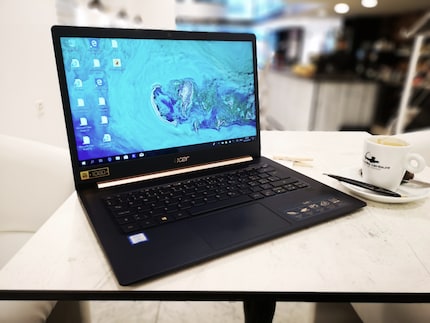
Conclusion
The Swift 5 is basically not a bad device. However, I have high expectations of the workmanship. I can overlook the fact that I don't feel like I'm holding a magnesium-lithium alloy case in my hands. What I can't forgive, however, is that the display bends just by folding it up. Acer should have installed better quality here for a device costing around one and a half thousand francs.
At 970 grams, the Swift 5 is clearly designed for mobility. To keep the weight so low, Acer has installed a small battery. This is at odds with the concept of mobility. If I only have a good four hours of juice on the go, that's anything but mobile. Where the Swift 5 disappoints in everyday tasks, it shines in terms of battery performance under full load. This at first glance contradictory result is due to the low TDP of 15 W.
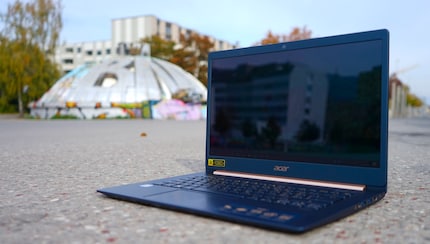
At around 1500 francs, the Swift 5 is not a cheap device. I would have liked more performance. Of course, I know that I can't game with the i7-8550U and the Intel Graphics UHD 620. Nevertheless, a little more performance in everyday use would be desirable at this price.
The display is another negative point. Instead of a touchscreen, for a device that cannot be used in tablet mode or tent mode, I would have liked more viewing angle stability and an anti-glare display. The anti-glare display also falls back into the limited mobility that I criticised. If I can't work due to bright light, a device is not mobile for me.
All of these points weigh too heavily for me to give a purchase recommendation for the Swift 5.
From big data to big brother, Cyborgs to Sci-Fi. All aspects of technology and society fascinate me.
